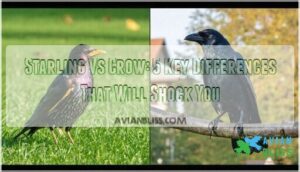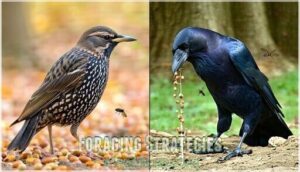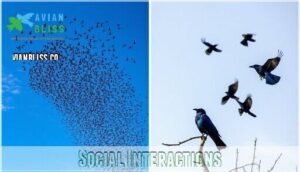This site is supported by our readers. We may earn a commission, at no cost to you, if you purchase through links.
 When comparing starling vs crow, you’ll notice distinct differences that make identification straightforward.
When comparing starling vs crow, you’ll notice distinct differences that make identification straightforward.
Starlings are smaller birds with iridescent, speckled plumage and pointed yellow beaks, belonging to the Sturnidae family. They’re roughly robin-sized with shorter tails and walk with a distinctive waddle.
Crows, from the Corvidae family, are substantially larger with completely black feathers, thick straight bills, and impressive wingspans. You’ll hear starlings’ mimetic calls versus crows’ harsh cawing.
Behaviorally, starlings form massive murmurations while crows gather in smaller, more strategic family groups. Their feeding habits differ too—starlings probe lawns for insects while crows scavenge opportunistically with tool-using intelligence.
Table Of Contents
- Key Takeaways
- Starling Vs Crow
- Feeding Habits Compared
- Habitat Preferences
- Social Interactions
- Ecological Impacts
- Frequently Asked Questions (FAQs)
- What’s the difference between a starling and a crow?
- Why are starlings despised?
- How do you tell if a bird is a starling?
- What bird is mistaken for a crow?
- Are starlings the same as crows?
- Do crows scare off starlings?
- What’s the difference between starlings and blackbirds?
- What’s the difference between a crow and a grackles?
- Are starlings or crows more intelligent?
- Which species has a longer lifespan?
- Conclusion
Key Takeaways
- You’ll easily distinguish these birds by size—crows are massive at 17-21 inches with thick black bills, while starlings are robin-sized at 7-9 inches with pointed yellow beaks and iridescent speckled plumage.
- You’ll notice completely different social behaviors—starlings create spectacular murmurations with thousands of birds moving as one synchronized unit, while crows gather in smaller, strategic family groups.
- You’ll observe distinct feeding strategies—crows use their superior intelligence for tool use and opportunistic scavenging, while starlings systematically probe lawns and soft ground for insects using rapid bill movements.
- You’ll recognize their contrasting ecological impacts—crows serve as beneficial natives that help control pests, while invasive starlings aggressively displace native cavity-nesting birds and cause over $800 million in annual agricultural damage.
Starling Vs Crow
You’ve probably seen both starlings and crows in your backyard, but telling these black birds apart requires knowing their distinct features.
These two species differ substantially in size, behavior, and ecological roles despite their similar dark appearance, which makes understanding their differences crucial for ecological roles.
Physical Characteristics
When you’re trying to tell starlings vs crows apart, size differences jump out immediately.
Starlings measure about 7-9 inches long with shorter, pointed beaks, while crows stretch 17-21 inches with thick, straight bills.
| Feature | Starling | Crow |
|---|---|---|
| Beak Shape | Pointed, yellow-orange | Thick, straight, black |
| Feather Color | Iridescent black-purple | Matte black |
| Wing Span | 12-17 inches | 33-40 inches |
| Eye Color | Dark brown | Black |
Behavioral Differences
While starling vs crow distinctions extend beyond appearance, their behavioral differences reveal fascinating contrasts.
These two species showcase distinct communication styles and foraging tactics that separate them in the avian world.
You’ll notice crows exhibit solitary hunting and complex problem-solving abilities, whereas starlings demonstrate synchronized flocking and aggressive territorial displays.
These species showcase distinct communication styles and foraging tactics that separate them in the avian world.
Understanding the crow vs blackbird characteristics can provide deeper insights into their behaviors and habitats.
| Behavior | Starlings | Crows |
|---|---|---|
| Communication Styles | Mimicry, varied calls | Deep caws, gestures |
| Foraging Tactics | Ground probing, groups | Tool use, opportunistic |
| Roosting Behaviors | Massive communal roosts | Small family groups |
Feeding Habits Compared
You’ll discover that these two birds employ completely different hunting techniques to secure their meals.
Starlings probe soft ground with their bills in a systematic pattern, while crows use their intelligence to manipulate tools and cache food for later consumption, which showcases their unique approach to securing meals, highlighting the use of intelligence.
Foraging Strategies
When you observe these birds foraging, you’ll notice stark differences in their hunting approaches.
Crows excel at tool use and opportunistic scavenging, while starlings master ground-probing techniques for insect hunting.
Understanding their unique feeding behaviors, such as ground feeding patterns, can provide insights into their adaptations.
Key foraging differences include:
- Starlings: Use rapid bill-probing (65-100 probes/minute) for seed gathering
- Crows: Employ tools and manipulate objects for food access
- Flock dynamics: Starlings benefit from group foraging; crows often work solo
Diet Composition
Digging into dietary specifics reveals fascinating contrasts between these species.
While crows demonstrate opportunistic flexibility in their food choices, starlings follow more predictable consumption patterns.
You’ll find starlings specializing in specific seasonal resources, creating distinct feeding niches that separate them from their corvid counterparts.
Understanding the various bird seed types is essential for attracting these birds to your yard.
| Food Type | Starling Preferences | Crow Preferences |
|---|---|---|
| Insect Consumption | Beetles, grubs, larvae | Varied insects, carrion |
| Seed Eating | Grass seeds, grains | Large seeds, nuts |
| Fruit Diet | Small berries, cherries | Larger fruits, eggs |
| Worm Hunting | Earthworms, soil invertebrates | Ground beetles, worms |
| Nut Foraging | Rarely consumed | Acorns, cached nuts |
This bird species comparison highlights how starling characteristics focus on smaller prey items, while crow behavior encompasses broader dietary flexibility and intelligence-driven food caching strategies.
Habitat Preferences
You’ll find these two species choose remarkably different neighborhoods to call home.
While crows prefer open woodlands and agricultural areas with scattered trees, starlings gravitate toward urban environments and densely populated human settlements.
Geographical Distribution
When you explore where starlings and crows live, you’ll discover fascinating geographic differences.
European starlings originated in Eurasia but rapidly colonized North America after 1890 introductions, while American crows remain primarily within their native North American range spanning Canada to northern Mexico.
Here are 5 key geographic distribution patterns:
- Native Range Origins – Starlings evolved across Europe and western Asia; crows developed throughout North America’s diverse ecosystems
- Migration Patterns – Northern starling populations migrate seasonally south, while most crow behavior patterns show minimal long-distance movement
- Habitat Range Expansion – Starlings achieved continental spread within 80 years; crows expanded more gradually through habitat modification
- Climate Zones Adaptation – Both species thrive in temperate regions but starlings show greater tolerance for varied climate zones
- Geographic Isolation Effects – Starling vs crow distributions reflect different colonization strategies and regional variations in habitat preferences
Environmental Adaptations
Through climate tolerance, these species showcase remarkable environmental flexibility.
These adaptable birds master diverse environments through remarkable biological flexibility and behavioral intelligence.
Crows exhibit superior cold weather adaptation with dense feather insulation, while starling migration patterns demonstrate seasonal movement strategies.
Crow behavior patterns include year-round residency in harsh climates, contrasting with starling habits of temperature-driven relocation.
Both species display beak adaptation for varied food sources and nesting strategies suited to diverse habitats within their respective starling social structure and crow habitat preferences.
The creation of suitable crow habitat products is essential for maintaining healthy crow populations.
Social Interactions
You’ll discover that starlings and crows differ dramatically in their social structures and group dynamics.
While starlings form massive, synchronized flocks called murmurations with thousands of individuals, crows maintain smaller family groups.
They establish complex territorial hierarchies through strategic communication and conflict resolution, which is a key aspect of their social behavior.
Flocking Behaviors
When you witness starling murmuration, you’re seeing one of nature’s most coordinated displays.
These bird species differences become clear through distinct flock dynamics:
- Starling social structure: Massive murmurations with thousands of birds moving as one synchronized unit
- Crow vs starling flight patterns: Crows form loose, smaller groups with individual decision-making
- Group coordination: Starlings use social learning for instantaneous directional changes, while crows maintain family-based clusters
Bird migration reveals how starling habits prioritize collective safety over individual autonomy.
Territorial Disputes
You’ll discover that crows and starlings wage intense Border Conflicts over prime real estate.
These Nesting Wars involve aggressive Territory Marking through crow calls and crow communication, while starlings counter with coordinated attacks.
Crow intelligence helps them dominate 78% of confrontations, but starlings’ murmuration tactics create effective group pressure.
Resource Competition drives most Agonistic Behavior between these territorial rivals. This behavior is influenced by their bird social interactions and adaptations to their environment.
Ecological Impacts
You’ll find that both crows and starlings create ripple effects throughout their ecosystems, but their impacts couldn’t be more different.
Understanding these ecological differences reveals why one species thrives as a beneficial native while the other disrupts entire food webs as an invasive competitor.
Competition With Native Species
You’ll discover starlings create serious problems for Native Species through aggressive Resource Competition.
These invasive birds displace native cavity-nesters like bluebirds and woodpeckers, reducing their nesting success by 44%.
Unlike crow intelligence that adapts to challenges, starlings overwhelm native birds through sheer numbers and aggressive tactics.
Their dominance disrupts Ecological Balance, making Species Coexistence nearly impossible and substantially impacting Biodiversity Impact in affected regions.
Understanding the importance of native bird habitats is vital to addressing these ecological issues.
Effects on Agriculture
Beyond their obvious differences, you’ll find starlings and crows devastate crops differently.
European starlings cause massive Crop Damage to soft fruits, while crows target corn seedlings during critical growth phases. Farmers can mitigate these effects by using effective crop damage methods.
- Agricultural Impact: Combined losses exceed $800M annually in U.S. agriculture
- Farm Management: Starling flocks overwhelm vineyards; crow families disrupt Pest Control balance
- Bird Conservation: Effective starling vs blackbird identification helps targeted Bird Watching Tips strategies
Frequently Asked Questions (FAQs)
What’s the difference between a starling and a crow?
You’ll spot key differences in size, color, and behavior.
Crows are larger black birds with straight bills, while starlings are smaller with iridescent plumage and pointed yellow bills during breeding season.
Why are starlings despised?
You’ll find starlings despised because they’re aggressive invaders that outcompete native birds, damage crops worth millions annually, and create massive, messy roosts in urban areas.
How do you tell if a bird is a starling?
Like a stocky blackbird wearing a polka-dot vest, you’ll identify starlings by their short yellow bills, iridescent dark plumage with white speckles, and compact build.
They’re smaller than crows with pointed wings.
What bird is mistaken for a crow?
Several black birds get mistaken for crows, especially ravens, grackles, and blackbirds. Ravens are larger with wedge-shaped tails, while grackles have iridescent plumage and longer tails than crows.
Are starlings the same as crows?
No, starlings and crows aren’t the same species.
You’re looking at two completely different bird families, with starlings belonging to Sturnidae, while crows are corvids.
They differ in size, behavior, and intelligence levels substantially.
Do crows scare off starlings?
You’ll witness nature’s ultimate showdown when these black birds clash.
Crows absolutely dominate starlings through superior size, aggressive territorial behavior, and coordinated flock attacks, effectively driving them away from food sources.
What’s the difference between starlings and blackbirds?
You’ll spot key differences in size and behavior between these species.
Starlings are smaller, speckled birds with iridescent feathers that flock together.
Blackbirds are larger, with males sporting jet-black plumage and bright orange beaks, preferring solitary ground foraging.
What’s the difference between a crow and a grackles?
Crows are larger, all-black corvids with thick beaks and harsh calls. Grackles are smaller, iridescent blackbirds with long tails and yellow eyes. You’ll notice crows hop while grackles walk confidently.
Are starlings or crows more intelligent?
Intelligence among avian species sparks fascinating debates.
Crows demonstrate superior problem-solving abilities, tool use, and complex social cognition compared to starlings.
You’ll find crows exhibit remarkable memory, planning skills, and adaptive learning that surpasses starlings’ capabilities.
Which species has a longer lifespan?
You’ll find that crows typically outlive starlings by a significant margin.
Crows can live 15-20 years in the wild, while starlings usually survive only 2-3 years, making longevity one area where these corvids clearly outshine their smaller counterparts, in terms of corvids.
Conclusion
Knowledge is power, and understanding these starling vs crow differences transforms casual birdwatching into informed observation.
You’ll now confidently distinguish between Sturnidae and Corvidae families through size, plumage patterns, and behavioral cues.
Whether you’re witnessing murmurations or observing corvid intelligence, you possess the taxonomic knowledge to appreciate each species’ unique ecological role.
These identification skills enhance your connection with avian biodiversity while supporting citizen science efforts in your local ecosystem.









